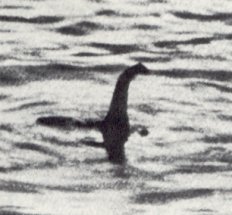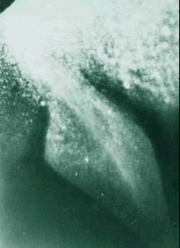Loch Ness Monster
The Loch Ness Monster, sometimes called "Nessie" or "Ness" (Scottish Gaelic: Niseag) is a controversial and unidentified animal or group of animals said to live in Loch Ness, a large deep freshwater loch near the city of Inverness in northern Scotland. more...
Nessie is usually categorized as a type of lake monster.
Along with Bigfoot and the Yeti (the "Abominable Snowman"), Nessie is one of the best-known mysteries in cryptozoology though most mainstream scientists and other experts find current evidence supporting Nessie unpersuasive and regard such reports as hoaxes or misidentification of mundane creatures or natural phenomena.
History of alleged sightings
Ancient
Rumours of a monster or animal living in the loch are claimed by believers to have been known for several centuries, though others have questioned the accuracy or relevance of such tales, which were generally unheard-of before the 1960s, when a strong wave of interest in legitimizing Nessie's 1930s-based history began.
The earliest claimed reference is taken from the Life of St. Columba by Adamnan. It describes how in 565 Columba saved the life of a Pict, who was being supposedly attacked by the monster. Adamnan describes the event as follows:
- "...(He) raised his holy hand, while all the rest, brethren as well as strangers, were stupefied with terror, and, invoking the name of God, formed the saving sign of the cross in the air, and commanded the ferocious monster, saying, "Thou shalt go no further, nor touch the man; go back with all speed." Then at the voice of the saint, the monster was terrified, and fled more quickly than if it had been pulled back with ropes, though it had just got so near to Lugne, as he swam, that there was not more than the length of a spear-staff between the man and the beast. Then the brethren seeing that the monster had gone back, and that their comrade Lugne returned to them in the boat safe and sound, were struck with admiration, and gave glory to God in the blessed man. And even the barbarous heathens, who were present, were forced by the greatness of this miracle, which they themselves had seen, to magnify the God of the Christians" .
Critics have questioned the reliability of the Life, noting a different story in which Columba slays a wild boar by the power of his voice alone 1. They also point out that the event is said to have occurred on the River Ness, not in the Loch, and that Adamnan reports Columba encountering and conquering assorted "monsters", at various places in Scotland, throughout his "life". Additionally, they point out that the Loch Ness monster has no other reported instance of attacking anyone, and in fact is generally portrayed as shy and people-avoidant.
Recent and Principal
The first recorded modern sighting occurred on May 2, 1933. The newspaper Inverness Courier carried a story of Mr. and Mrs. John Mackay, who reportedly saw "an enormous animal rolling and plunging on the surface." The report of the "monster" (a word chosen by the editor of the Courier) became a media sensation with London papers sending reporters to Scotland, and a circus even offering a reward of £20,000 for capture of the monster. It was at this point that the belief in a monster-inhabited Loch Ness first began to take form.
Later that year, A.H. Palmer, who allegedly witnessed Nessie on August 11, 1933, at 7 a.m., described the creature as having its head, which they saw from the front, set low in the water. Its mouth, which had a width of between twelve and eighteen inches (30-45 cm), was opening and closing; its maximum mouth aperture was estimated to be about six inches (15 cm).
Further preoccupation with the Loch Ness Monster was aroused by a photograph allegedly taken by surgeon R.K. Wilson on April 1 (All Fool's Day), 1934, which seemed to show a large creature with a long neck and head lifted above the water. Decades later, on March 12, 1994, Christian Spurling claimed to have faked the photo after being hired by the Daily Mail to track down Nessie (the photo had by that time been printed worldwide as "absolute evidence"). Spurling also stated that Wilson did not take the photo, and his name was only used to give added credibility to the photo.
Regardless of whether anything is actually in the loch, the Loch Ness Monster has some significance for the local economy. Dozens of hotels, boating tour operators, and merchants of stuffed animals and related trinkets owe part of their livelihood to this monster, although people visit the loch for many reasons other than to see the monster. Hence, the legend is likely to endure for quite some time.
Theories
Most accounts of Nessie's appearance, including historical ones, indicate a creature resembling the long-extinct plesiosaur. Actual fossil evidence for this Mesozoic creature shows it to have been physically large, with a long neck and tiny head, with flippers for propulsion. The alleged connection of this creature with the Loch Ness monster has made it a popular topic in the field of cryptozoology. However, most scientists suggest the idea that the Loch Ness Monster is a remnant of the Mesozoic era is highly unlikely; there would need to be a breeding colony of such creatures for there to have been any long-term survival, and coupled with the fact that plesiosaurs needed to surface to breathe, this would result in far more frequent sightings than have actually been reported (though some animals, such as crocodiles, that need to breathe air intermittently, can stay underwater for extended periods of time by remaining still and conserving their oxygen supply). Many biologists also argue Loch Ness is not large or productive enough to support even a small family of these creatures. Moreover, the loch was created as the result of geologically recent glaciation and was frozen solid during recent ice-ages.
Other sightings, however, do not fit the plesiosaur description or even a water-bound creature: In April 1923, Alfred Cruickshank claimed to have seen a creature 3 m to 3.5 m long, with an arched back and four elephant-like feet cross the road before him as he was driving. Other sightings report creatures more similar to camels or horses.
Read more at Wikipedia.org




